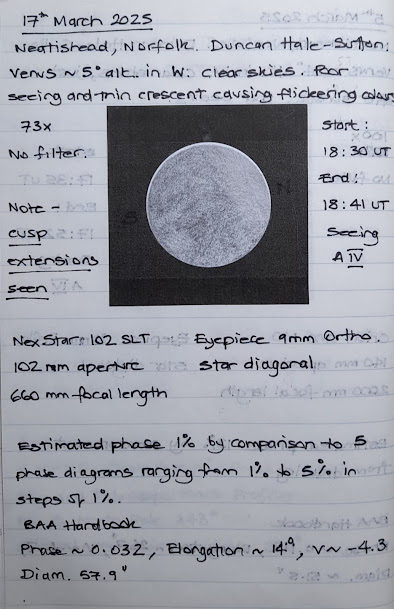The 2024-2025 eastern elongation of Venus is now over as the planet reached inferior conjunction on the 23rd March and is now appearing in the morning sky. Before this happened I was able to make a few more observations of the planet as its phase shrank to a thin crescent. Firstly, I saw the planet on the 5th March 2025 in clear skies but relatively poor seeing. Venus was at an altitude of about 24 degrees in the West just after sunset. Here is the page from my notebook:-
I made the drawing using my 140mm Orion Maksutov-Cassegrain between 17:35 and 17:52 UT. The phase has shrunk considerably since my last drawing on the 25th January. From the drawing I estimated that the phase was 13% by measurement. This was slightly larger than the predicted phase of 11.2% predicted by the BAA. Notice also how the size of the planet has grown considerably from 29.6 arc seconds on the 25/1/25 to 51.5 arc seconds in this observation.
On the 13th March at 18:16 UT I captured an image of Venus using my Tasco 18-36x spotting scope:-
This terrestial telescope has an aperture of about 50mm. This picture was taken at 36x and I used my Samsung phone to capture it. At this time the phase of Venus was about 5% and the planet was at an elongation of 19 degrees.
The final drawing I made of Venus was on the 17th March and by then the phase appeared to have shrunk to just 1%:-
Here I used my NexStar 102 SLT set up at the front of the house which is west facing. Venus was by this date not very far above the horizon after sunset (a mere 5 degrees in the west). The low altitude caused the seeing to be very poor but it made for a very beautiful sight. The crescent of the lit side was so thin that the atmosphere caused the image to flicker in different colours, like diamonds on a necklace. What's more, after careful observation, it was possible to see that the cusps of the crescent had extended further round the planet than would be expected for solid body with no atmosphere and I have tried to show this in my drawing. The cusps on such a body would be expected to end diametrically opposite each other where the terminator meets the edge of the planet. Instead the light carries on past this point causing appearance of the cusps to curve back on each other. I was very pleased to see that Paul Abel at the BAA produced a very similar drawing a day later.
By comparing what I could see at 73x with 5 phase diagrams ranging in phase from 1 to 5% in steps of 1% I estimated the phase to be 1% and this is smaller than the 3% predicted by the BAA.
Finally, on the 18th March at 18:12 I captured my last image of Venus using my spotting scope at 36x again:-







